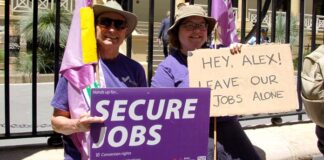NSW teachers have won a pay increase and the reinstatement of a state-wide staffing plan as part of a new 3-year-award.
An initial pay rise of 4.4% will be followed by two rises of 3.8% in successive years. The offer was made after the NSW Teachers Federation threatened industrial action over a 2.5% offer from the NSW Government last year. A threat to link pay to performance, part of Rudd and Gillard’s ‘education revolution’, was also defeated.
However, the deal falls well below what could have been won: union members originally voted for a 5% increase and were prepared to take strike action to support the claim on the first two days of the school year. Critically, the agreement has created further differences between the awards of school teachers and TAFE-based teachers. This reduces the ability of these teachers to unite in future disputes over pay, conditions and education accessibility and quality. TAFE is currently under pressure from Federal moves to push market reforms. The NSW Teachers Federation has agreed to a joint working party to look at reforms and trade-offs to make up for the pay rise for some sections of TAFE workers. This will include loss of pay or non face-to-face preparation time, cuts in sick leave and increased reporting requirements.
None of these trade-offs had to occur. The mass meetings that voted for strike actions demanded no trade-offs and showed clear support from teachers to take up the fight for better pay with no concessions attached. The state-wide staffing plan is also heavily conditional. School principals now have increased powers to knock back position applicants, allowing conservative principals to pick and choose teachers. It is easy to see how union activists and politically-active teachers could be left out in the cold.
Strike plans were called off when the NSW Government reversed its current position and agreed to negotiate. The Teachers Federation could have taken full opportunity of the government retreat. The NSW government is suffering the lowest polls in 25 years. Premier Nathan Rees is a replacement for the hugely unpopular Iemma, whose plan to sell of power assets brought his and Costa’s downfall. This reality would have been well-known to the Industrial Relations Commission.
The two-day strike, combined with a rally at Parliament House, could have been part of a sustained campaign to crack the weak government’s neo-liberal agenda of productivity trade-offs and a victory against Rudd’s calls for ‘wage restraint’ in the face of economic crisis. Teachers were outraged at the government’s original pitiful offer. This wave of anger should have been channelled into immediate industrial action.
Successive union leaderships have seen industrial action as a last resort, rather than an expresison of solidarity and strength and a way to cohere school, TAFE, corrective services and AMES language teachers. In future campaigns, activists will need to work at winning members to the need to organise on the ground for militant action as an alternative to expecting justice from governments or the Industrial Relations Commission.





